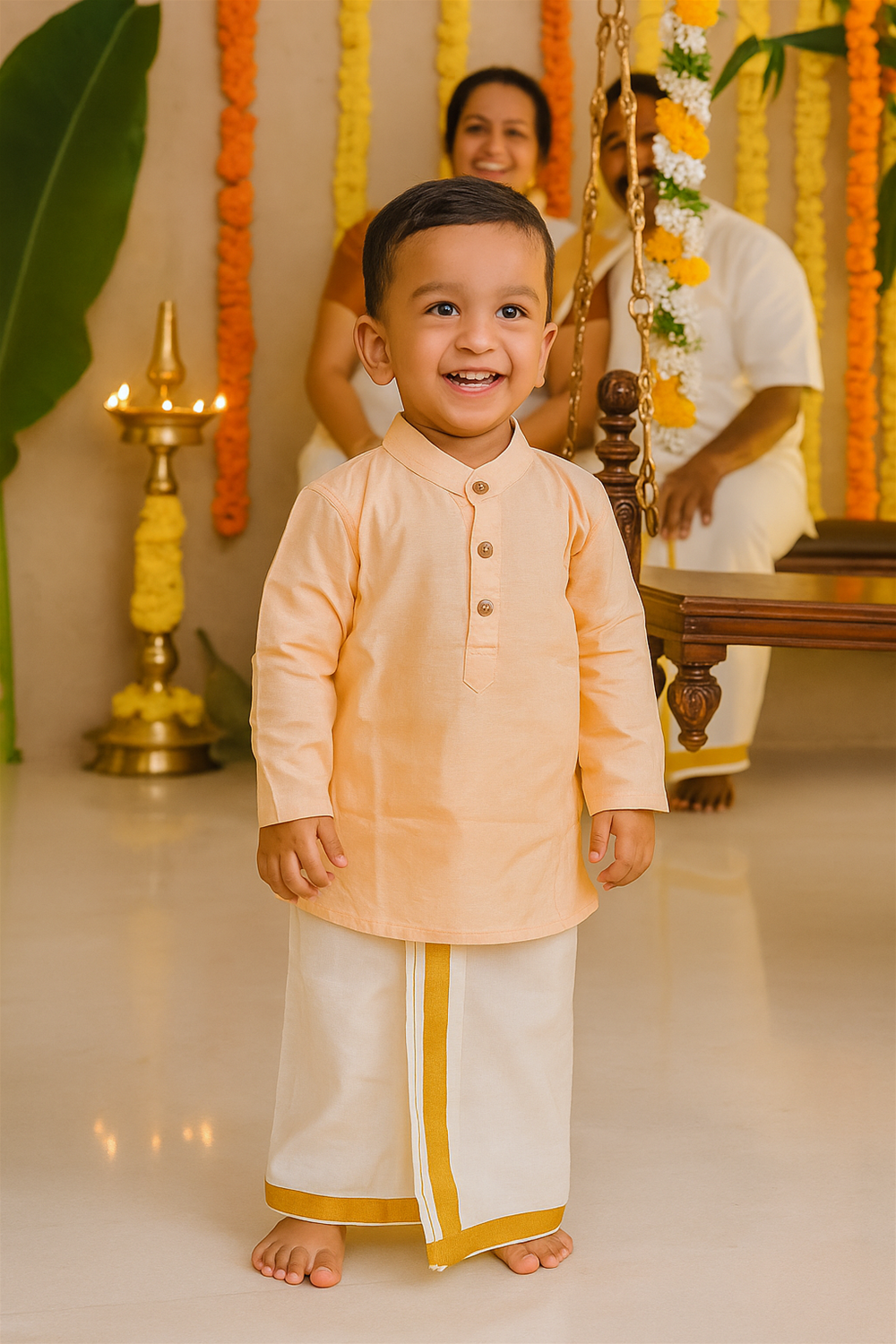
26524 Plain Peach Linen Cotton Boys Full sleeves kurtha with buttons
Send With EMS Speed Post
Flexible returns
This boy’s outfit features a peach cotton kurtha with a mandarin collar and button placket, paired with an ivory Kerala mundu with gold kasavu border. Combining tradition with comfort, the kurtha offers full sleeves, neat tailoring, and breathable fabric, perfect for festivals like Onam and Vishu. The vibrant peach tone adds modern freshness, while the mundu preserves cultural authenticity. Ideal for rituals, weddings, and celebrations, it reflects elegance, tradition, and child-friendly wearabi
1. Fabric and Material
The kurtha is crafted from soft breathable cotton, ensuring maximum comfort for toddlers. Cotton is chosen deliberately for festive wear as it absorbs sweat, allows air circulation, and is gentle on sensitive skin. The peach shade enhances the richness of the cotton, making it appear fresh yet traditional. Its lightness ensures the child can play freely, while the texture gives a festive touch, suitable for cultural occasions like Onam, Vishu, and weddings.
2. Color Palette
The peach tone of the kurtha is a masterstroke in blending subtlety with elegance. Peach represents freshness, warmth, and youthful energy—perfectly aligning with the innocence of childhood. The kurtha’s color doesn’t overshadow but complements the ivory-white mundu with golden border, forming a visually balanced and celebratory attire. Peach is also a versatile color—it blends harmoniously with marigold flower garlands, festive backdrops, and traditional Kerala décor, making the outfit ideal for cultural photography.
3. Neckline and Collar Design
The kurtha features a bandhgala-inspired mandarin collar. This collar style is traditional yet modern, offering a neat frame around the neckline. It provides structure without being restrictive, adding elegance to the boy’s appearance. The collar also highlights the buttons, creating a sophisticated yet child-friendly design. In Indian tradition, mandarin collars signify purity and discipline, which makes this design perfect for ceremonial attire while ensuring a princely look for the young wearer.
4. Button Placket Detailing
The three-button placket down the chest is both functional and decorative. The buttons, in earthy wooden tones, contrast gently against the peach fabric, adding visual interest without overwhelming the design. They serve as practical closures for dressing convenience while contributing to the overall aesthetic. Their placement balances symmetry and enhances the kurtha’s vertical line, giving the child a taller, regal look. The stitching around the placket is neat, showing attention to fine tailoring.
5. Sleeves and Fit
The kurtha has full-length sleeves that are slightly loose, ensuring unrestricted movement. Unlike stiff ceremonial wear, this design prioritizes comfort by allowing ample room for hand movement during play or cultural activities like flower arrangement (pookalam). The sleeve length also makes it appropriate for traditional gatherings where modesty and grace are valued. The overall fit is tailored but not body-hugging, keeping the boy stylish yet comfortable. This balance of elegance and ease is vital in children’s ethnic fashion.
6. Kurtha Length and Hem Finish
The kurtha extends slightly below the hips, falling neatly over the mundu. The hemline is straight, stitched cleanly to prevent curling or discomfort. This length is ideal—it doesn’t ride up easily, nor does it restrict walking or sitting on the floor during festive rituals. The neat finish indicates quality tailoring, a critical factor in ethnic children’s wear where durability matters as much as appearance. The kurtha pairs seamlessly with traditional Kerala mundu or pajama pants.
7. Mundu (Dhoti) Pairing
The boy is dressed in a classic Kerala mundu in ivory white with a bold gold zari border. This combination reflects Kerala’s cultural attire, where mundus with golden kasavu borders are staples during Onam, Vishu, and temple visits. The mundu sits high on the waist with pleats allowing freedom of movement. Its simplicity enhances the kurtha’s peach shade, creating a refined yet festive appearance. The golden border ties the outfit together, symbolizing prosperity and festivity.
8. Styling and Cultural Significance
This ensemble perfectly captures Kerala’s ethnic heritage while adapting to modern sensibilities. The peach kurtha departs from conventional cream or white tones, introducing vibrancy while maintaining tradition. The mundu grounds the outfit in authenticity, representing Kerala’s timeless sartorial legacy. Such attire is commonly chosen for family ceremonies, temple visits, and festivals. It embodies a sense of belonging, cultural pride, and elegance, teaching children the value of tradition from an early age while keeping them stylish.
9. Occasion Suitability
This kurtha-mundu combination is versatile for multiple occasions—Onam celebrations, where families dress in kasavu; Vishu kani rituals, which emphasize purity; weddings, where the child can mirror traditional male attire; and family photoshoots, where the vibrant peach kurtha stands out against festive floral backdrops. The outfit combines practicality (cotton comfort) and ceremonial elegance, making it suitable for both indoor rituals and outdoor celebrations. Its subtle grandeur makes it ideal for toddlers, striking a balance between innocence and sophistication.
10. Overall Aesthetic and Appeal
The peach cotton kurtha with mundu achieves a harmonious blend of modern vibrancy and cultural authenticity. The subtle sheen of cotton, the charm of the mandarin collar, the neat button placket, and the mundu’s kasavu border collectively create a picture-perfect festive look. Beyond aesthetics, it reflects thoughtful craftsmanship tailored for children—lightweight, breathable, and symbolic. The outfit evokes joy, pride, and tradition, turning the boy into the embodiment of cultural celebration, while maintaining playful innocence.


